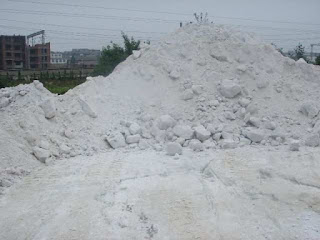Ore washing method and equipments
Sinonine know that in a beneficiation plant, if ore material
content much more mud or impurity, it should adopt washing process to enrich the ore
first and then to next separation processing such as flotation, gravity,
magnetic etc. Washing is mainly used
in the enrichment process of industrial minerals, coal, aggregates, sand and gravel, normally with the
products in solid form. (size =1 mm and coarser).
Washing
equipments include Log washers, Wet Screens, Aquamator Separators, Tumbling
Scrubbers, Attrition Scrubbers etc.
Log washers
Single or double
shaft log washers are used for washing of gravel. Contaminated material is fed
at the trough bottom and is transported upwards by blades in a screw pattern
due to friction between the material. Effluent in slurry form leaves via an
overflow weir.
Water spraying
can be used to wash materials on a screen regardless of hole size in the
screening media. If the hole size is 20 mm or less, water spraying increases
the capacity (inversely proportional to the hole size).
Aquamator separator
The Aquamator is
developed for efficient washing of waste material of lower densities like coal,
wood etc. Used mainly for gravel, chippings and demolition rubble. The water
and feed form a bed with a density high enough
enabling light material to float off.
Tumbling scrubber
If solids of
rock, gravel or minerals contain a high and sticky content of clay and dirt
that has to be removed, wet screening is normally not effective enough. A
medium speed washing drum for scrubbing solids against solids is then the
option. The drum is relatively short in relation to its diameter. Water
requirements per ton is the same as for wet screening.
Attrition scrubber
These scrubbers
are mainly used for washing of material below 10 mm in size. Very high energy
inputs are possibly used for washing of silica sand for glass making and
cleaning of foundry sand. The machine is also suitable for clay blunging and
lime slacking.
All washing operations
are normally consuming a lot of expensive water. Not only costly, but also
containing a lot of washing effluents both coarse and fine. Water and effluents
that have to be processed partly to recover some value (coarse material and
water), partly to protect the environment from damage (sludge fractions).







评论
发表评论